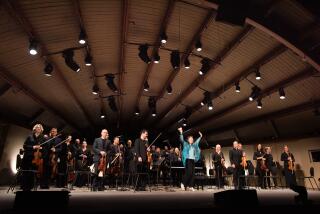She’s tied to the koto, but not to its tradition
Her fingers dance upon the strings, and like a river or wind, the sounds of the koto carry June Okida Kuramoto. The ancient Japanese instrument drew her in with its angelic voice when she was a little girl, and, over time, it became her voice too.
The song is tentatively titled “Manzanar” and will be included on her band Hiroshima’s 13th CD, “The Bridge,” due out this summer. It was co-written by Okida Kuramoto and Dan Kuramoto, her ex-husband, who founded the group in the early 1970s.
It is a song about human suffering, injustice, strength, beauty and the wind. Dan’s parents were among those of Japanese ancestry incarcerated at Manzanar during World War II. He wanted to write a song about the experience while they were still alive.
Okida Kuramoto wrote the melody based on a pilgrimage she made years ago with former internees. As she was returning home, the sun was setting behind Manzanar’s Sierra Nevada backdrop. The sky turned purple and red and orange and blue, and she was struck by its beauty.
That the sun can be beautiful wherever it sets is akin to her take on the koto, a revered instrument in her native Japan once performed only for the nobility. If its sound was beautiful in classical Japanese music, couldn’t it also be beautiful in Western contemporary music?
The koto is at the heart of Hiroshima’s music. About 6 feet long and crafted from wood of the paulownia tree, the traditional koto has 13 strings and is said to resemble a dragon.
“It’s a living thing,” says Okida Kuramoto, who has introduced the instrument to a broader audience. “It’s a tree and the more you play it, the more you touch it, the more it sings, because it’s been loved.”
A friend once brought her a koto that had been in storage since World War II. She brought it back to life by cleaning it up, then for hours at a time every day for two weeks, rubbing it with her hands.
Hiroshima combines contemporary instruments with traditional Japanese instruments to create a unique blend of multicultural music. The band has sold more than 3 million albums. Its 1981 recording of “Winds of Change” was nominated for a Grammy.
Dan Kuramoto plays shakuhachi, a bamboo flute, as well as saxophones, flutes and keyboards. Johnny Mori played taiko in the band until last year, when he took a job in the performing arts department at the Japanese American Cultural and Community Center in Little Tokyo. Drummer-percussionist Danny Yamamoto also plays taiko. Other members are Kimo Cornwell, who plays piano, keyboards and synthesizers; and Dean Cortez on bass.
When they first started, Okida Kuramoto says, she was hoping to take the koto in a new direction and, as part of the band’s “One World” approach, create music uniquely Japanese American. She didn’t anticipate controversy.
Many Japanese people, however, were critical of her and the band. Other koto players called her “vulgar” for breaking with tradition and incorporating the koto, Japan’s official national instrument, into the band’s fusion of jazz, Latin rhythms, and rhythm and blues.
During the band’s 1998 Japanese tour, a reporter questioned her about the resentment.
First, she cried. Then she stepped to the bathroom to regain her composure, and when she returned, she told the reporter: “I love this instrument. I respect this instrument. I love the culture.... You can say whatever you want, but this is what I have to do and this is what I love to do, and this is what I need to do.”
If her use of the koto was divisive in Japan, in the U.S. it serves as a link to the Asian American community, a relationship that has played a vital role in the band’s longevity.
Over the years, when times got tough or members pulled apart, it was the concept that held them together. Even when she and Dan Kuramoto divorced in 1984, Okida Kuramoto decided that nothing should stand in the way of their music.
Now, at 54, she finds herself at a crossroads. Last year, she stopped working her part-time job, as a legal assistant, and in November she released her first solo CD, “Spirit and Soul.”
Her daughter is grown, and for the first time Okida Kuramoto is able to focus entirely on music. But is that what she wants?
She says she feels there is a journey she must take, and she’s not sure what it is. Maybe it’s spiritual or political or social.
“The band should never be the end,” she says. “It should always be the means to an end.
“Sometimes I wonder if I hide behind the music too much. I mean, look at the world today. Maybe I should be out there helping instead of playing music.”
But, for now, the koto remains her voice. As in Japanese culture, her message is sometimes conveyed through feelings rather than words, and as the band rehearses “Manzanar,” an instrumental, she leans over the koto and closes her eyes as she plays. Dan Kuramoto blows evenly into the shakuhachi. He remembers how his mother would say that the wind at Manzanar sounded so lonely at night. The song unfolds like sunset. A beautiful sky, a lonely wind.
*
The koto
In the beginning: The koto originated in China and was introduced to Japan around the 7th century.
The wood matters: Paulownia trees used to make kotos must be at least 20 years old. According to Chinese legend, the paulownia tree is an omen of good luck.
First koto players: Initially, it was a specialty of blind performers.
String rules: The 13 strings are of the same thickness. Each string is tuned by a movable bridge.
The essentials: Three picks are worn, on the right-hand thumb, index finger and middle finger.


